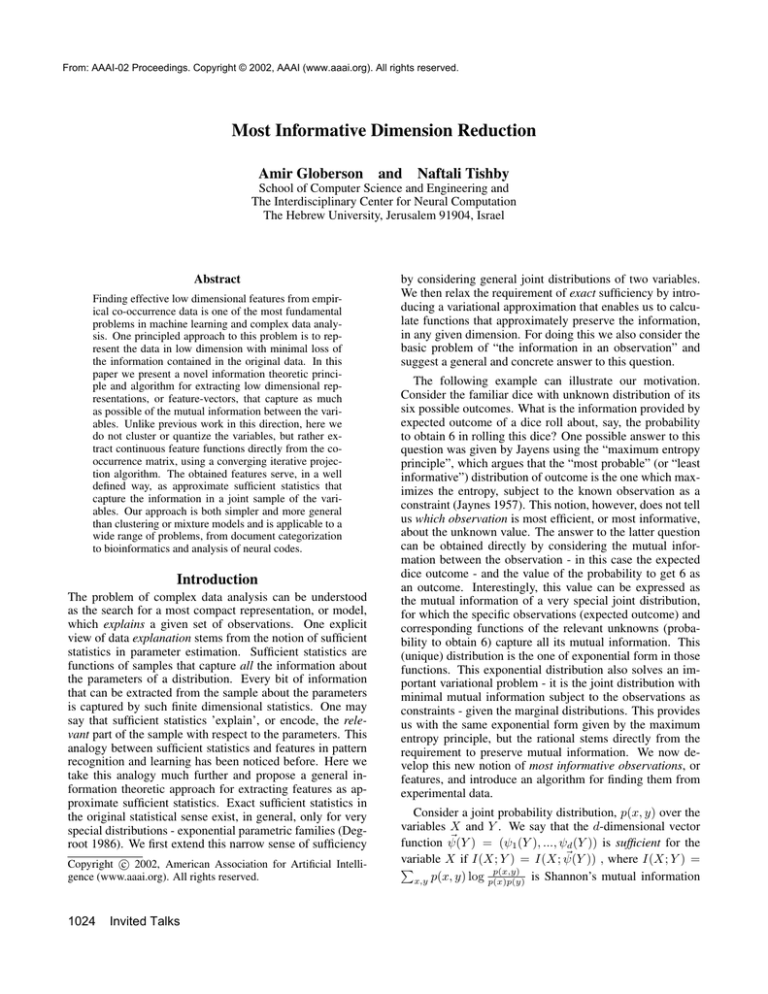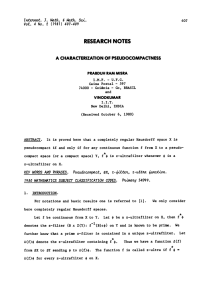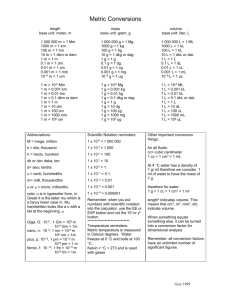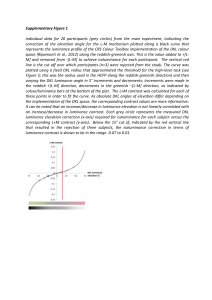
From: AAAI-02 Proceedings. Copyright © 2002, AAAI (www.aaai.org). All rights reserved.
Most Informative Dimension Reduction
Amir Globerson
and
Naftali Tishby
School of Computer Science and Engineering and
The Interdisciplinary Center for Neural Computation
The Hebrew University, Jerusalem 91904, Israel
Abstract
Finding effective low dimensional features from empirical co-occurrence data is one of the most fundamental
problems in machine learning and complex data analysis. One principled approach to this problem is to represent the data in low dimension with minimal loss of
the information contained in the original data. In this
paper we present a novel information theoretic principle and algorithm for extracting low dimensional representations, or feature-vectors, that capture as much
as possible of the mutual information between the variables. Unlike previous work in this direction, here we
do not cluster or quantize the variables, but rather extract continuous feature functions directly from the cooccurrence matrix, using a converging iterative projection algorithm. The obtained features serve, in a well
defined way, as approximate sufficient statistics that
capture the information in a joint sample of the variables. Our approach is both simpler and more general
than clustering or mixture models and is applicable to a
wide range of problems, from document categorization
to bioinformatics and analysis of neural codes.
Introduction
The problem of complex data analysis can be understood
as the search for a most compact representation, or model,
which explains a given set of observations. One explicit
view of data explanation stems from the notion of sufficient
statistics in parameter estimation. Sufficient statistics are
functions of samples that capture all the information about
the parameters of a distribution. Every bit of information
that can be extracted from the sample about the parameters
is captured by such finite dimensional statistics. One may
say that sufficient statistics ’explain’, or encode, the relevant part of the sample with respect to the parameters. This
analogy between sufficient statistics and features in pattern
recognition and learning has been noticed before. Here we
take this analogy much further and propose a general information theoretic approach for extracting features as approximate sufficient statistics. Exact sufficient statistics in
the original statistical sense exist, in general, only for very
special distributions - exponential parametric families (Degroot 1986). We first extend this narrow sense of sufficiency
c 2002, American Association for Artificial IntelliCopyright gence (www.aaai.org). All rights reserved.
1024
Invited Talks
by considering general joint distributions of two variables.
We then relax the requirement of exact sufficiency by introducing a variational approximation that enables us to calculate functions that approximately preserve the information,
in any given dimension. For doing this we also consider the
basic problem of “the information in an observation” and
suggest a general and concrete answer to this question.
The following example can illustrate our motivation.
Consider the familiar dice with unknown distribution of its
six possible outcomes. What is the information provided by
expected outcome of a dice roll about, say, the probability
to obtain 6 in rolling this dice? One possible answer to this
question was given by Jayens using the “maximum entropy
principle”, which argues that the “most probable” (or “least
informative”) distribution of outcome is the one which maximizes the entropy, subject to the known observation as a
constraint (Jaynes 1957). This notion, however, does not tell
us which observation is most efficient, or most informative,
about the unknown value. The answer to the latter question
can be obtained directly by considering the mutual information between the observation - in this case the expected
dice outcome - and the value of the probability to get 6 as
an outcome. Interestingly, this value can be expressed as
the mutual information of a very special joint distribution,
for which the specific observations (expected outcome) and
corresponding functions of the relevant unknowns (probability to obtain 6) capture all its mutual information. This
(unique) distribution is the one of exponential form in those
functions. This exponential distribution also solves an important variational problem - it is the joint distribution with
minimal mutual information subject to the observations as
constraints - given the marginal distributions. This provides
us with the same exponential form given by the maximum
entropy principle, but the rational stems directly from the
requirement to preserve mutual information. We now develop this new notion of most informative observations, or
features, and introduce an algorithm for finding them from
experimental data.
Consider a joint probability distribution, p(x, y) over the
variables X and Y . We say that the d-dimensional vector
) = (ψ1 (Y ), ..., ψd (Y )) is sufficient for the
function ψ(Y
)) , where I(X; Y ) =
variable X if I(X; Y ) = I(X; ψ(Y
p(x,y)
x,y p(x, y) log p(x)p(y) is Shannon’s mutual information
between X and Y (Cover & Thomas 1991).1 In this case
the information about X in a sample of Y , for a given value
X = x, is completely captured by the empirical expectation
), namely, by ψ(Y
)p(Y |x) . Similarly, one can say
of ψ(Y
that the functions φ(X) = (φ1 (X), ..., φd (X)) are sufficient
for Y if I(X; Y ) = I(φ(X);
Y ). In that case the dual problem of the information about a given Y = y from a sample
of X is captured by φ(X)
p(X|y) . The interesting question
we address in this work is if we can find such dual sets of
) and φ(X),
functions, ψ(Y
simultaneously.
A complete simultaneous dimensionality reduction, that
preserves all the information in the original joint distribution, is possible in general only for special classes of p(x, y),
that are of an exponential form. However, these observations motivate a variational approach that finds such a re ) and φ(X)
duction if one exists, but extracts functions ψ(Y
that approximate such a reduction in a well defined information theoretic sense. The duality of these two function sets
is a key component of our approach. We further show that
this variational principle has other suggestive interpretations
which make it a viable candidate for a general principled
dimensionality reduction or feature extraction technique.
Problem formulation
We assume that we are given a joint distribution of two
variables p(x, y). In most practical cases we are in fact
given only a finite sample from such a distribution, as a cooccurrence matrix. This empirical joint distribution enables
us to estimate expectation values of functions of x and y. We
also assume that the marginal distributions, p(x) and p(y),
are known or can be well estimated. This latter assumption
simplifies our analysis and algorithm, but can be relaxed. We
first deal with just one of the two dual problems: finding the
). We later show that the resulting algorithm in fact
set ψ(Y
solves the two problems simultaneously, and this apparent
asymmetry will be removed.
We look for a set of d functions (or features) of the variable y, denoted by ψi (y) for i = 1 . . . d, whose expectations
can capture the information in the joint distribution in the
following information theoretic sense.
The functions ψi (y) should satisfy two complementary
requirements. On the one hand their expectation should
capture all the information about the values of x, thus no
other information on y can be assumed. This means that we
should minimize the information, subject to the known expected values, ψi (y)p(y|x) for every x, as constraints. On
the other hand, the functions ψi (y) should be selected such
that these expectations provide the maximum possible information on the variable X.
Given a candidate set of d functions ψi , we denote by
p̃(x, y) the distribution with minimal information under the
expectation constraints. Namely
p̃(x, y) = arg
min
q(x,y)∈P(ψi (y),p)
1
I[q(x, y)]
(1)
In the conventional notation of parameter estimation X is a d
dimensional parameter vector Θ, and Y is an n dimensional i.i.d
sample from p(y|Θ).
q(x,y)
where I[q(x, y)] =
x,y q(x, y) log p(x)p(y) and the set
P(ψi (y), p) is the set of distributions that satisfy the constraints, defined by
ψi p̃(y|x) = ψi p(y|x)
p̃(x) = p(x)
P(ψi (y), p) = p̃(x, y) :
p̃(y) = p(y)
∀x .
(2)
The second requirement should select the best possible candidate functions ψi , by maximizing this information over all
possible d functions ψ.
Together this can be written as a single Max-Min problem
for the optimal functions ψi∗ (y),
ψi∗ (y) = arg max
min
I(p̃(x, y)) .
ψi (y) p̃(x,y)∈P(ψi (y),p)
(3)
Notice that this variational principle does not define a generative statistical model for the data and is in fact a model
independent approach. As we show later, however, the resulting distribution p̃(x, y) can be interpreted as a generative model in a class of exponential form. But there is no
need to make any assumption about the validity of such a
model for the data. The data distribution p(x, y) is needed
only to estimate the expectations ψ(y)
for every x, given
the candidate features.
In what follows we present an iterative projection algorithm, which finds a local solution of this variational problem, and prove its convergence using information geometrical tools. We also show that this asymmetric variational
problem for finding the functions ψi (y) is in fact equivalent
to the dual problem of finding the functions φi (x) and in
fact the two problems are solved simultaneously. Our iterative algorithm uses any MaxEnt algorithm, such as “iterative
scaling”(Darroch & Ratcliff 1972), as its inner component.
Using it we perform alternating projections between two (infinite) sets of linearly constrained distributions.
The problem as formulated provides a tool for data dimensionality reduction, and as such is applicable for a wide
range of problems, from natural language processing to neural code analysis and bioinformatics. An illustrative document classification application will be presented. As we discuss further, this variational problem is similar in structure
to the fundamental problem of the capacity of an unknown
channel which suggests other interesting interpretations for
our procedure. It is also related to the recently proposed
Information Bottleneck Method (Tishby, Pereira, & Bialek
1999) as well as to other dimensionality reduction algorithms, such as LSA(Deerwester et al. 1990), LLE(Roweis
& Saul 2000) and non-negative matrix factorization (Lee &
Seung 1999).
The nature of the solution
We first show that the problem as formulated in Eq. 3 is
equivalent to the problem of minimizing the KL divergence
between the empirical distribution p(x, y) and a large (parametric) family of distributions of an exponential form.
To simplify notation, we sometimes omit the suffix of
(x, y) from the distributions. Thus p̃t stands for p̃t (x, y) and
p for p(x, y)
Invited Talks
1025
Minimizing the mutual information in Eq. 1 under the
linear constraints on the expectations ψ(y)
is equivalent
to
maximizing
the
joint
entropy,
H[p̃(x, y)] =
− x,y p̃(x, y) log p̃(x, y), under these constraints, with the
additional requirement on the marginals, p̃(x) = p(x) and
p̃(y) = p(y). Due to the concavity of the entropy and
the convexity of the linear constraints, there exists a unique
maximum entropy distribution (for compact domains of x
and y) which has the exponential form,
d
1
∗
p̃ψ(y)
(x, y) = exp
φi (x)ψi (y) + A(x) + B(y) ,
Z
i=1
(4)
d
where Z = x,y exp
φ
(x)ψ
(y)
+
A(x)
+
B(y)
i
i
i=1
is the normalization (partition) function 2 .
The functions φi (x) are uniquely determined as Lagrange
multipliers from the expectation values ψi (y). This exponential form is also directly linked to our interpretation of
the functions ψi and φi as conjugate sufficient statistics.
One key property of the exponential form, Eq. 4, is that
it is the only joint distribution for which the mutual information between x and y is completely captured by the dual
function vectors, ψi (y), φi (x). Namely, it is the only joint
distribution p̃(x, y) for which the following equality holds,
I[p̃(x, y)] = I(ψ; φ) .
(5)
This property manifests the fact that the reduced description of the x and y by φ and ψ indeed catures the relevant
structure of the joint distribution. It makes it clear why one
would like to find a good approximation to the given joint
distribution, which is of this form.
The set of distributions of the exponential form in
Eq. 4 can also be considered as a parametric family,
parametrized by the infinite family of functions Θ =
[ψi (y), φi (x), A(x), B(y)] (note we treat ψ and φ symmetrically).
We denote this family by PΘ and a member of the family
by pΘ . Naturally, p̃∗ψ(y)
∈ PΘ .
We define the set of distributions PΨ ⊂ PΘ :
ψi p̃(y|x) = ψi p(y|x)
p̃(x) = p(x)
PΨ = p̃ ∈ PΘ :
p̃(y) = p(y)
∀x p̃∈PΨ
(7)
We now return to the information maximization problem,
i.e. the selection of the feature candidates ψ(y).
For every
p̃ ∈ PΨ one can easily show that
I[p̃] = I[p] − DKL [p|p̃] ,
(8)
p
where DKL [p|q] = x,y p log q . The above expression has
two important consequences. The first is that maximizing
2
Note that the unique distribution can actually be on the closure
of such exponential forms. We do not address this detail here.
1026
Invited Talks
p̃∈PΨ
In addition, Eq. 8 shows that the information in I[p̃∗ ] can
not be larger than the information in the original data. This
supports the intuition that the model p̃∗ maintains only properties present in the original distribution that are captured by
the selected features ψi∗ (y), for any value of x.
The problem in Eq. 9 is a maximization of a function
over a subset of PΘ , namely PΨ . The following proposition shows that this is in fact equivalent to maximizing the
same function over all of PΘ .
Proposition 1 arg minp̃∈PΨ DKL [p|p̃]
=
arg minp̃∈PΘ DKL [p|p̃]
Proof: We need to show that the distribution which minimizes the right hand side is in PΨ . Indeed, by taking the
(generally functional) derivative of DKL [p(x, y)|p̃] w.r.t. the
parameters Θ in p̃, one obtains the following conditions:
∀x, i ψi (y)p̃(y|x) = ψi (y)p(y|x)
∀y, i φi (x)p̃(x|y) = φi (x)p(x|y)
∀x
p̃(x) = p(x)
∀y
p̃(y) = p(y) .
(10)
Clearly, this distribution satisfies the constraints in
P(ψi (y), p) and is therefore in PΨ .
Our problem is thus equivalent to the minimization problem:
p∗ = arg min DKL [p|p̃] .
(11)
p̃∈PΘ
Equation 11 is symmetric with respect to φ and ψ, thus removing the asymmetry between X and Y in the formulation
of Eq. 3.
Notice that this minimization problem can be viewed as a
Maximum Likelihood fit to the given p(x, y) in the class PΘ ,
but since nothing on its own guarantees the quality of this
fit, nor justifies the class PΘ , we prefer the information theoretic, model independent, interpretation of our approach.
An Iterative Projection Algorithm
. (6)
The problem presented above (Eq. 3) is then equivalent to
finding the information maximizing distribution in PΨ ,
p̃∗ = arg max I[p̃] .
I[p̃] for p̃ ∈ PΨ is equivalent to minimizing DKL [p|p̃] for
p̃ ∈ PΨ :
p̃∗ = arg min DKL [p|p̃] .
(9)
Our main result is an iterative algorithm for solving the MaxMin variational problem, Eq. 3, which provably converges
to a minimum of Eq. 11. We describe the algorithm using
the information geometric notion of I-projections (Csiszar
1975).
The I-projection of a distribution q(x) on a set of distributions P is defined as the distribution p∗ (x) in P which
minimizes the KL-divergence DKL [p|q].
p∗ (x) = arg min DKL [p|q] .
p∈P
(12)
We shall use the notation p∗ (x) = IP R(q, P).
An important property of the I-projection is the, so called,
Pythagorean property (Cover & Thomas 1991). For every
distribution p in P the following holds:
DKL [p|q] ≤ DKL [p|p∗ ] + DKL [p∗ |q] .
(13)
We now focus on the case where the set P is a convex set
determined by expectation values. Given a set of d functions
fi (x) and a distribution p(x), we denote the set of distributions which agree with p(x) on the expectation values of
fi (x), by P(fi (x), p(x)). Namely,
P(fi (x), p(x)) = p̃(x) : fi (x)p̃(x) = fi (x)p(x)
(14)
The I-projection in this case has the exponential form
1
IP R(q(x), P(fi (x), p(x))) = ∗ q(x) exp
λ∗i fi (x) ,
Z
i
(15)
where λ∗i is the Lagrange multiplier corresponding to
fi (x)p(x) . In addition, for this special set, the Pythagorean
inequality actually becomes an equality (Csiszar 1975).
Before describing the algorithm, we need some additional
notations:
• p̃t (x, y) - the distribution after t iterations.
• ψi,t (y) - the ψi (y) functions for p̃t (x, y), Lagrange multipliers for φi,t−1 (x).
• φi,t+1 (x) - the φi (x) functions for p̃t+1 (x, y), Lagrange
multipliers for ψi,t (y).
• Θt - the full parameter set for p̃t (x, y).
The iterative projection algorithm is outlined in figure 1.
In this figure the algorithm is described through iterated
I-projections of (exponential) distributions, once for fixed
ψi (y) and their expectations, and then for fixed φi (x) and
their expectations. Interestingly, during the first projection,
the functions φi (x) are modified as Lagrange multipliers for
ψi (y), and vice-versa in the second projection. The iteration can thus be viewed as alternating mapping between the
two sets of d-dimensional functions, ψi and φi . This is also
the direct goal of the variational problem.
We proceed to prove the convergence of the algorithm.
We first show that every step reduces DKL [p(x, y)|p̃t (x, y)].
Proposition 2 DKL (p(x, y), p̃t+1 (x, y))
≤
DKL (p(x, y), p̃t (x, y)) .
Proof: For each x, the following is true:
• p̃t+1 (y|x) is the I-projection of p̃t (y|x) on the set
P(ψi,t (y), p(y|x)) .
• p(y|x) is also in P(ψi,t (y), p(y|x)) .
Using the Pythagorean property, (which is an equality here)
we have that DKL [p(y|x)|p̃t (y|x)] is equal to:
DKL [p(y|x)|p̃t+1 (y|x)] + DKL [p̃t+1 (y|x)|p̃t (y|x)] . (16)
Multiplying by p(x) and summing over all x values, we obtain:
DKL [p|p̃t ] = DKL [p|p̃t+1 ] + DKL [p̃t+1 |p̃t ] .
(17)
where we have used p̃t (x) = p(x). Note that the summation
resulted in the term DKL [p(x)|p̃t+1 (x)] on both sides of the
equation.
Using the non-negativity of DKL [p̃t+1 |p̃t ] we have:
DKL [p|p̃t ] ≥ DKL [p|p̃t+1 ] .
(18)
Note that equality is obtained iff DKL [p̃t+1 |p̃t ].
Input: Joint (empirical) distribution p(x, y)
Output: 2d feature functions: ψi (y) φi (x) that result
from p̃∗ , a solution of the variational problem Eq. 3 and a
(local) minimum of Eq. 9.
Initialization:
• Initialize p̃0 (x, y) ∈ PΘ randomly
Iterate:
• For all x, set:
p̃t+1 (y|x) = IP R(p̃t (y|x), P(ψi,t (y), p(y|x)))
p̃t+1 (x, y) = p̃t+1 (y|x)p(x).
The functions φi,t+1 (x) are determined as the Lagrange
multipliers
• For all y, set:
p̃t+2 (x|y) = IP R(p̃t+1 (x|y), P(φi,t+1 (x), p(x|y)))
p̃t+2 (x, y) = p̃t+2 (x|y)p(y).
The functions ψi,t+1 (y) are determined as Lagrange multipliers
• Halt on convergence (when small enough change in
p̃t (x, y)).
Figure 1: The iterative projection algorithm.
An analogous argument proves that:
DKL [p|p̃t+2 ] ≤ DKL [p|p̃t+1 ] .
(19)
The following easily provable proposition states that the
stationary points of the algorithm coincide with extremum
points of the target function DKL [p|pΘ ]. Its proof uses the
properties of the projections in the algorithm, and the characterization of the extremum point in Eq. 10.
Proposition 3 If p̃t = p̃t+2 then the corresponding Θt sat∂
DKL [p|pΘ ] = 0 .
isfies ∂Θ
It is now easy to prove convergence of the algorithm to
a local minimum of DKL [p|pΘ ] using continuity arguments
and the improvement at each iteration given in Eq. 17. We
will give a detailed proof in a separate paper.
Implementation - Partial I-projections
The description of the iterative algorithm assumes the existence of a module which calculates I-projections on linear constraints. Because no closed form solution for such
a projection is known, it is found by successive iterations
which asymptotically converge to the solution. It is straightforward to show that even if our projection algorithm uses
such a ”Partial I projection” algorithm as its IPR module, it
still converges to a minimum.
In this work we use as an IP R algorithm the Generalized Iterative Scaling (GIS) procedure (Darroch & Ratcliff
1972), described in figure 2. Alternative algorithms such as
Invited Talks
1027
Improved Iterative Scaling (Pietra & Lafferty 1997) or conjugate gradient methods, can also be used and may improve
convergence rate.
Input: Distributions q(x), p(x), d functions fi (x)
Output: IP R(q(x), P(fi (x), p(x)))
Initialize: p0 (x) = q(x)
Iterate:
• pt+1 (x) =
1
Zt pt (x) exp
d
i=1
fi (x) log
fi (x)p(x)
fi (x)pt (x)
• Zt is a normalization constant
Figure 2: The Generalized Iterative Scaling Algorithm.
Discussion
Our proposed method is a new dimensionality reduction
technique. It is nonlinear, unlike PCA or ICA, and it aims
directly at preserving mutual information in a given empirical co-occurrence matrix. We achieved that through an information variation principle that enables us to calculate simultaneously informative feature functions for both random
variables. In addition we obtain an exponential model approximation to the given data which has precisely these features as dual sets of sufficient statistics. We described an alternating projection algorithm for finding these features and
proved its convergence to a (local) optimum. This is in fact
an algorithm for extracting optimal sets of constraints from
statistical data. We briefly address now several other important issues that our procedure raises.
Finite samples The basic assumption behind our problem
formulation is that we have the joint distribution of the variables x and y, p(x, y). For the machine learning community
this assumption may look strange, but one should remember
that the goal is not to learn the mapping from X to Y , but
rather to extract good features of X w.r.t. Y . In fact, p(x, y)
is not needed explicitly, but only to estimate the expectation
values ψ(y)
and φ(x).
These can be estimated uniformly
well from a finite sample under the standard uniform convergence conditions. In other words, standard learning theoretical techniques can give us the sample complexity bounds,
given the dimensions of X and Y and the reduced dimension d. For continuous x and y further assumptions must be
made, such as the VC dimension of the features, etc.
Uniqueness of the solution Interestingly, while the goal
of the algorithm are features that preserve information, the
information in the functions ψ(y)
and φ(x)
is not estimated
directly at any point. Furthermore, there is a freedom in selecting the features that stems from the fact that only the
dot-product φ(x)
· ψ(y)
appears in the distribution p̃(x, y).
−1
Any invertible matrix R can be applied such that φ(x)R
and Rψ(y)
are equally good features. One can remove this
ambiguity by orthogonalization and scaling of the feature
1028
Invited Talks
functions, for example by applying SVD to log p̃(x, y). Notice, however, that our procedure is very different from direct
application of SVD to log p(x, y). These two coincide only
when the original joint distribution is already of the exponential form of Eq.( 4). In all other cases SVD based approximations (LSA included) will not preserve information
as well as our features at the same dimension reduction. The
resulting functions ψ(y)
and φ(x)
thus depend on the initial
point of the iterations, but the information extracted does not
(for the same optimum).
Information theoretic interpretation Our information
MaxMin principle is close in its formal structure to the problem of channel capacity with some channel uncertainty (see
e.g. (Lapidoth & Narayan 1998)). This suggests the interesting interpretation for the features as channel characteristics.
If the channel only enables the reliable transmission of d ex
pected values, then our ψ(y)
exploit this channel in an optimal way. The channel decoder of this case is provided by
the dual vector φ(x)
and the decoding is performed through
a dot-product in of these two vectors. This intriguing interpretation of our algorithm obviously requires further analysis.
Relations to other algorithms
Dimension reduction algorithms have become a fundamental component in unsupervised large scale data analysis, together with clustering. While linear methods, as PCA and
ICA, provide very useful first steps, they do not provide a
principled method for statistical co-occurrence data, where
such linear assumptions about the matrix are unjustified.
Several interesting non-linear methods have been proposed
in the past years. Of particular interest are
LLE(Roweis & Saul 2000) and non-negative matrix factorization (Lee & Seung 1999). We feel that none of these
new algorithms directly address the question of information
preserving as we suggest here. Furthermore, preliminary
comparisons of our algorithm with LSA (Deerwester et al.
1990) for document indexing are very encouraging and justify our non-linear approach. A closely related idea is the
Information Bottleneck Method (Tishby, Pereira, & Bialek
1999) which aims at a clustering that preserves information. However, clustering may not be the correct answer for
many problems where the relationship between the variables
comes from some hidden low dimensional continuous structures. In such cases clustering tends to quantize the data in a
rather arbitrary way, while low dimensional features are simpler and easier for interpretation. The resulting algorithm is
also computationally simpler, with no need for complicated
splitting or merging of clusters.
Acknowledgement
We thank Noam Slonim and Gal Chechik for helpful discussions and comments and for the help with experimental
data. This work is partly supported by a grant from the Israeli Academy of Science. A.G. is supported by the Eshkol
Foundation.
References
Cover, T., and Thomas, J. 1991. Elements of information theory.
Wiley.
Csiszar, I. 1975. I-divergence geometry of probability distributions and minimization problems. Annals of Probability
3(1):146–158.
Darroch, J., and Ratcliff, D. 1972. Generalized iterative scaling
for log-linear models. Ann. Math. Statist. 43:1470–1480.
Deerwester, S.; Dumais, S.; Landauer, T.; Furnas, G.; and Harshman, R. 1990. Indexing by latent semantic analysis. Journal of
the American Society of Information Science 41(6):391–407.
Degroot, M. 1986. Probability and Statistics. Addison-Wesley.
Jaynes, E. 1957. Information theory and statistical mechanics.
Physical Review 106:620.
Lapidoth, A., and Narayan, P. 1998. Reliable communication under channel uncertainty. IEEE Transactions on Information Theory 44(6):2148–2177.
Lee, D., and Seung, H. 1999. Learning the parts of objects by
non-negative matrix factorization. Nature 401(6755):788–791.
Pietra, S. D., and Lafferty, V. D. P. J. 1997. Inducing features of
random fields. IEEE Transactions on PAMI 19(4):380–393.
Roweis, S., and Saul, L. 2000. Nonlinear dimensionality reduction by locally linear embedding. Science 290(5500):2323–6.
Tishby, N.; Pereira, F.; and Bialek, W. 1999. The information bottleneck method. In Proc. of the 37-th Annual Allerton Conference
on Communication, Control and Computing, 368–377.
Invited Talks
1029







